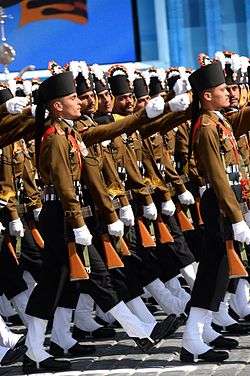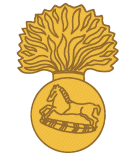The Grenadiers
| The Grenadiers | |
|---|---|
|
The regimental insignia of The Grenadiers | |
| Active | 1778–present |
| Country |
|
| Branch | Army |
| Type | Infantry |
| Size | 15,200 |
| Regimental Centre | Jabalpur, Madhya Pradesh |
| Motto(s) | Sarvada Shaktishali (Ever Powerful) |
| Mascot(s) | The Lion |
| Engagements |
Second Anglo-Afghan War |
| Decorations | |
| Battle honours |
Post Independence Gurez, Assal Uttar, Jarpal and Chakra |
| Commanders | |
| Colonel of the Regiment | Lt General Shakti Gurung, PVSM, UYSM, AVSM, VSM, Military Secretary |
| Insignia | |
| Regimental Insignia | A brass grenade bearing the White Horse of Hanover. The insignia is worn on the uniform with a white hackle. |
The Grenadiers are an infantry regiment of the Indian Army, formerly part of the Bombay Army and later the pre-independence Indian Army, when the regiment was known as the 4th Bombay Grenadiers. It has distinguished itself during the two world wars and also since the Independence of India. The regiment has won many battle honours and gallantry awards, with three Param Vir Chakra awardees in three different conflicts.
Early history
The oldest grenadier regiment of the armies in the Commonwealth belongs to the Indian Army. The concept of 'Grenadiers' evolved from the practice of selecting the bravest and strongest men for the most dangerous tasks in combat. The Grenadiers have the longest unbroken record of existence in the Indian Army.[1]
The history of the Indian Grenadiers is linked to the troops recruited for the Army of the Bombay Presidency. The very first mention of a grenadier company hails back to 1684, when a little army of English troops, which had taken possession of the island of Bombay and comprising three companies of Europeans and local Christians, had a grenadier company, but nothing was heard about this unit subsequently. In 1710, the Bombay Army consisted of five companies of "Europeans, topasses (Indian christians), and coffrees (Kaffirs or African slaves)" of which the first company was a European grenadier company. This company was merged into the Bombay European Regiment, which was later disbanded. In 1757, Robert Clive had raised the 1st Regiment of the Bengal Native Infantry of which two companies were grenadier companies, however, no regiments of grenadiers were formed from the Bengal Army until a battalion was formed in 1779.
In 1759, as a response to French manoeuvring in South India, the strength of the Bombay Army was enhanced, and the first company of sepoy grenadiers was raised with the best of Bombay sepoys "paying a regard to those having families on the island". It had only native officers and all sepoys wore red coats faced with blue. Later on, an adjutant was appointed to the corps.
Later the Bombay Army comprised a number of sepoy battalions, each having one or two grenadier companies. These were clubbed together as a composite battalion comprising the grenadier companies of the Bombay sepoy battalions, and they won the famous battle of Talegaon in 1778. So impressive was the performance of this composite battalion that the Bombay Presidency ordered the permanent raising of a grenadier battalion which duly took place on 12 March 1779, thirty-six years before the first time that a British battalion was given the honour of calling itself "grenadiers". The Governor General of Bombay made an Order dated 12 November 1779, according to which the grenadier companies of the following regiments combined to form the very first Grenadier Regiment in the world, namely "The Grenadier Battalion, First Regiment of Infantry":
- 1st Sepoy Battalion
- 2nd Sepoy Battalion
- 3rd Sepoy Battalion
- 4th Sepoy Battalion
- 5th Sepoy Battalion
- 6th Sepoy Battalion
- Marine Battalion (two companies of grenadiers)
Battle honours

Battle Honour (Pre-Independence)
Prior to Indian independence, the Regiment had won many battle honours as part of the British Indian Army. These battle honours include:
Pre-World War I
- Mangalore – 1784
- Mysore – 1786
- Srirangapatnam – 1799
- Egypt – 1802
- Koregaum – 1818
- Beni Boo Alli – 1821
- Kirkee – 1827
- Hyderabad – 1831–43
- Meeane – 1843
- Punjab – 1848
- Central India – 1858
- Abyssinia – 1868
- Afghanistan – 1878–1880
- Kandahar 1880
- Afghanistan 1878–80
- Burma 1885–87
- Somaliland (Dharatol) – 1901–04
World War I

- East Africa 1914–16
- Egypt – 1916–17
- Baghdad – 1917
- Kut-Al-Amara – 1917
- Gaza – 1917
- Battle of Sharqat – 1918
- Megiddo
- Nablus – 1918
- Palestine 1917–18
- Mesopotamia – 1915–18
- Aden – 1914–19
- Afghanistan 1919
- Tigris – 1919
World War II
- Kohima – 1944
- Kalewa – 1944
- Naga Village – 1944
- Fort Dufferin,Mandalay – 1945
- Pwabwe – 1945
- Capture of Meiktila – 1945
- Defense of Meiktila – 1945
- Pegu – 1945
- Taungtha – 1945
Battle Honour (Post-Independence)
Since 1947, the Regiment has won the following battle honours as part of the Indian Army:
- Gurais – 1948
- Asal Uttar – 1965
- Jarpal – 1971
- Chakra – 1971
- Tololing & Tiger Hill (Kargil War) – 1999
Decorations
The Grenadiers have the unique and distinct honour of having the most number of Param Vir Chakras, India's highest medal for gallantry, among all the Indian Army's Infantry Regiments. Of note also, is the fact that prior to independence, British officers serving with The Grenadiers won four Victoria Crosses.[2] Members of the Regiment have also received a number of other decorations prior to independence, including the Indian Order of Merit.
Victoria Cross
- Captain George Murray Rolland, 22 April 1903, Daratoleh, Somaliland
Indian Order of Merit
- Subedar Rahim Khan, Palestine (against Turkey), April 1918.[3]
- Naik Shivlal Dalal (1933)
Param Vir Chakra Recipients
- Company Quarter Master Havildar Abdul Hamid, 4th Grenadiers – 1965.
- Major Hoshiar Singh, 3rd Grenadiers – 1971.
- Grenadier Yogendra Singh Yadav, 18th Grenadiers – 1999.
References & notes
Bibliography
- Barthorp, Michael; Burn, Jeffrey (1979). Indian infantry regiments 1860–1914. Osprey Publishing. ISBN 0-85045-307-0.
- Rinaldi, Richard A (2008). Order of Battle British Army 1914. Ravi Rikhye. ISBN 0-9776072-8-3.
- Sharma, Gautam (1990). Valour and sacrifice: famous regiments of the Indian Army. Allied Publishers. ISBN 81-7023-140-X.
- Sumner, Ian (2001). The Indian Army 1914–1947. Osprey Publishing. ISBN 1-84176-196-6.
- Moberly, F.J. (1923). Official History of the War: Mesopotamia Campaign, Imperial War Museum. ISBN 1-870423-30-5
- Singh, Rajendra (1969) History of the Grenadiers
- Singh, Rajendra (1955) Organisation and Administration in the Indian Army
See also
External links
- Official Website of Indian Army
- bharat-rakshak.com – The Grenadiers
- Indian Grenadiers Regiment
- The Bombay Grenadiers

